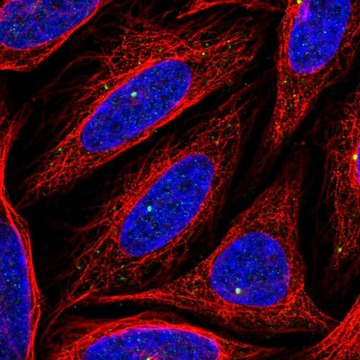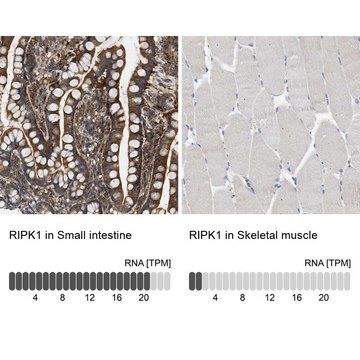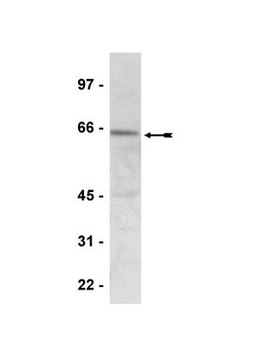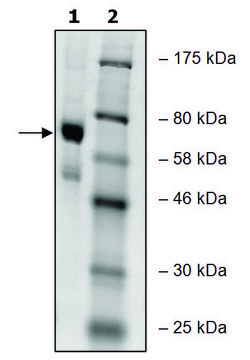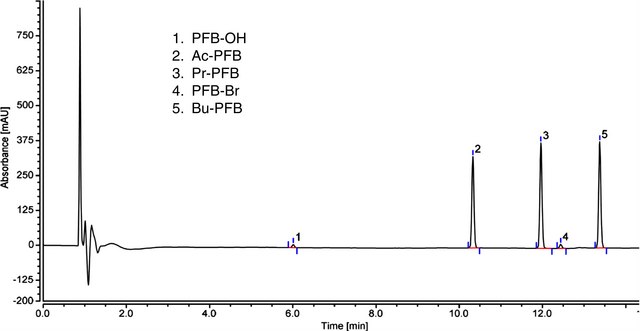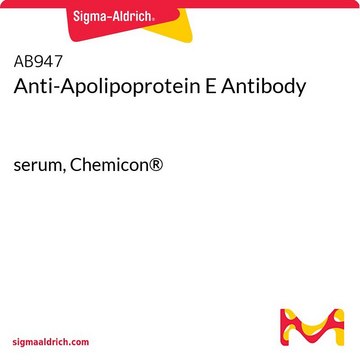推荐产品
生物来源
rabbit
质量水平
抗体形式
purified antibody
抗体产品类型
primary antibodies
克隆
polyclonal
种属反应性
human
技术
immunocytochemistry: suitable
western blot: suitable
同位素/亚型
IgG
NCBI登记号
UniProt登记号
运输
ambient
靶向翻译后修饰
unmodified
基因信息
human ... CEP164(22897)
一般描述
Centrosomal protein of 164 kDa (UniProt: Q9UPV0; also known as Cep164) is encoded by the CEP164 (also known as KIAA1052, NPHP15) gene (Gene ID: 22897) in human. Cep164 is expressed in several cell lines and it plays a role in microtubule organization and/or maintenance for the formation of primary cilia (PC), a microtubule-based structure that protrudes from the surface of epithelial cells. Cep164 localizes specifically to very distally located appendage structures on the mature centriole from which PC formation originates and it persists at centrioles throughout mitosis. Hence, it can serve as a marker for distal appendages on mature centrioles or basal bodies. Cep164 also plays a vital role in G2/M checkpoint and nuclear divisions. It is a key participant in the DNA damage-activated ATR/ATM signaling cascade and is required for the proper phosphorylation of H2AX, replication protein A, and check point kinases 1 and 2. Its phosphorylation at Ser186 is induced upon DNA-damage caused by treatment with IR irradiation, UV irradiation, hydroxyurea or amphidicolin. Mutations in CEP164 gene are known to cause nephronophthisis, a disease characterized by blindness in childhood, facial dysmorphism, bronchieclasis, liver failure and progression to end-stage renal failure.
特异性
This polyclonal antibody detects Centrosomal protein of 164 kDa in human. It targets an epitope within the first 298 amino acids from the N-terminal region.
免疫原
Epitope: N-terminus
His-taggged recombinant fragment of the first 298 amino acids from human Centrosomal protein of 164 kDa (CEP164).
应用
Anti-CEP164, Cat. No. ABE2621, is a highly specific rabbit polyclonal antibody that targets Centrosomal protein of 164 kDa and has been tested in Immunocytochemistry and Western Blotting.
Immunocytochemistry Analysis: A representative lot detected CEP164 in U2OS cells and hTERT-RPE1 cells that were serum starved for 48 hours (Graser, S., et. al. (2007). J Cell Biol. 179(2):321-30; Sonnen, K.F., et. al. (2012). Biol Open. 1(10):965-76).
Western Blotting Analysis: A representative lot detected CEP164 in total lysates of HeLa S3, U2OS, and 293T cells as well as 293T cells overexpressing myc-Cep164 (Graser, S., et. al. (2007). J Cell Biol. 179(2):321-30).
Western Blotting Analysis: A representative lot detected CEP164 in total lysates of HeLa S3, U2OS, and 293T cells as well as 293T cells overexpressing myc-Cep164 (Graser, S., et. al. (2007). J Cell Biol. 179(2):321-30).
Research Category
Epigenetics & Nuclear Function
Epigenetics & Nuclear Function
质量
Evaluated by Western Blotting in U2OS cell lysate.
Western Blotting Analysis: A 1:500 dilution of this antibody detected CEP164 in 10 µg of U2OS cell lysate.
Western Blotting Analysis: A 1:500 dilution of this antibody detected CEP164 in 10 µg of U2OS cell lysate.
目标描述
~200 kDa observed; 164.31 kDa calculated. Uncharacterized bands may be observed in some lysate(s).
外形
Protein A purified
Format: Purified
Purified rabbit polyclonal antibody in buffer containing 0.1 M Tris-Glycine (pH 7.4), 150 mM NaCl with 0.05% sodium azide.
储存及稳定性
Stable for 1 year at 2-8°C from date of receipt.
其他说明
Concentration: Please refer to lot specific datasheet.
免责声明
Unless otherwise stated in our catalog or other company documentation accompanying the product(s), our products are intended for research use only and are not to be used for any other purpose, which includes but is not limited to, unauthorized commercial uses, in vitro diagnostic uses, ex vivo or in vivo therapeutic uses or any type of consumption or application to humans or animals.
未找到合适的产品?
试试我们的产品选型工具.
储存分类代码
12 - Non Combustible Liquids
WGK
WGK 1
法规信息
新产品
Thao P Phan et al.
Genes & development, 36(11-12), 718-736 (2022-07-01)
Centrosomes are microtubule-organizing centers comprised of a pair of centrioles and the surrounding pericentriolar material. Abnormalities in centriole number are associated with cell division errors and can contribute to diseases such as cancer. Centriole duplication is limited to once per
Phillip Scott et al.
The Journal of cell biology, 222(12) (2023-09-29)
Polo-like kinase 4 (PLK4) is a key regulator of centriole biogenesis, but how PLK4 selects a single site for procentriole assembly remains unclear. Using ultrastructure expansion microscopy, we show that PLK4 localizes to discrete sites along the wall of parent
Olivier Mercey et al.
Nature cell biology, 21(12), 1544-1552 (2019-12-04)
Multiciliated cells (MCCs) amplify large numbers of centrioles that convert into basal bodies, which are required for producing multiple motile cilia. Most centrioles amplified by MCCs grow on the surface of organelles called deuterosomes, whereas a smaller number grow through
我们的科学家团队拥有各种研究领域经验,包括生命科学、材料科学、化学合成、色谱、分析及许多其他领域.
联系技术服务部门